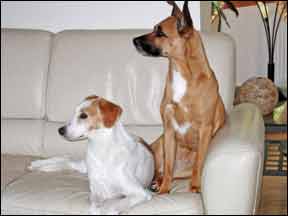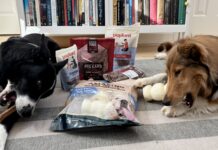This is the debut of what we intend to be a regular feature in Whole Dog Journal: a detailed critique of a home-prepared diet. I will analyze diets that people feed their dogs and offer feedback and suggestions that might improve the nutritional value of the diet.

288
Raw, Boneless Diet for an Active 37-lb dog
Fiona McNair lives in Glasgow, Scotland. McNair feeds a raw, boneless diet to her two dogs: Tara, a lean and very active six-year-old Staffordshire Terrier-cross who weighs 16.9 kg (37 lbs), and Pepi, a moderately active and slightly overweight four-year-old Podenco-cross who weighs 15.5 kg (34 lbs).
Both dogs are healthy, but McNair has noticed a few problems, including clicking in the joints, that started after she began feeding a homemade diet a year ago. I took a particularly close look at McNair’s diet to try to determine what nutrients might be missing or excessive in hopes of resolving this issue.
Here is the diet McNair currently feeds her larger dog (the smaller dog gets the same foods in slightly reduced quantities). These amounts are daily totals, split between two meals:
-250 grams (8.8 ounces) raw meat, including 1 day of lamb and 2 days each of beef, chicken, and turkey per week. Both lamb and beef are 20 percent fat; chicken is skinless breast and turkey is skinless dark meat.
-125 grams (4.4 ounces) vegetables, including raw grated carrot, courgette (zucchini), and celery, and steamed broccoli, cauliflower, Brussels sprouts, and turnips.
-85 grams (3 ounces) plain low-fat yogurt.
-20 grams (1.4 ounces) each raw lamb liver and kidney.
-Daily supplements: 1,000 mg Animal Essentials Seaweed Calcium, 500 mg vitamin C, 100 IUs vitamin E, vitamin B-50 complex, and 1,000 mg fish oil.
-Both dogs also get a few small treats plus a small rawhide daily.
At first glance, this diet looked pretty good, with appropriate proportions of meat, organs, and vegetables, and good variety. It is a little high in fat, but that’s okay for a very active dog (feeding less of the beef and lamb might help the smaller dog to lose weight).
Some other initial thoughts: Eggs and fish are missing. Adding starchy foods would help to reduce the fat content. Vegetables would be better digested if pureed in a food processor, blender, or juicer rather than just grated, and the Brussels sprouts and turnips may need more cooking to be digestible (raw vegetables aren’t harmful but don’t provide as much nutritional value as cooked vegetables).
Surprise!
When I entered the diet into a recipe at NutritionData.com and compared it to National Research Council (NRC) recommendations, I was a little surprised to find that it did not provide their recommended daily amounts (RDA) of several nutrients:
-Zinc (diet provides 9.2 mg; the RDA is 17 mg)
-Manganese (0.3 mg; RDA 1.3 mg)
-Choline (137 mg; RDA 465 mg)
-Vitamin D (7 IU; RDA 149 IU)
If McNair failed to add the supplement, the diet would also be very low in vitamin E (1 mg; RDA 8 mg). It would also be low in magnesium if she were using plain calcium or ground eggshell instead of the seaweed calcium (the diet supplies 96 mg, RDA is 164 mg; the Animal Essentials calcium supplement adds 90 mg).
The dietary iron (7.1 mg; RDA 8 mg) and phosphorus (732 mg; RDA 830 mg) are also below recommended amounts. It’s possible that this diet is low in iodine (264 mcg RDA), but I could not confirm this, as iodine is not tracked by the USDA’s nutrient database (which is where NutritionData.com gets its information). There is iodine in yogurt and in the Animal Essentials calcium supplement (60 mcg), and this may be adequate.
Vitamin K is also short, but since this vitamin can be synthesized in the intestines, it may not need to be supplied through diet.
Calcium is a little high (1,230 mg; RDA 1,080 mg), due to the amount provided by yogurt.
Also, the number of calories provided by this diet is inadequate for a dog of Tara’s size. When I mentioned this to McNair and inquired about Tara’s weight, McNair acknowledged that Tara has been losing weight. McNair had calculated the amount to feed based on a percentage of Tara’s ideal body weight, but had included the vegetables in the calculations.
Greens and other non-starchy vegetables are low in calories and should not be included when calculating how much to feed your dog. They can be added in whatever quantities are preferred.
Both omega-3 and omega-6 essential fatty acids (EFAs) were high enough to meet NRC recommendations. The diet is a little short in alpha-linolenic acid (ALA), a plant-based form of omega-3, but since dogs don’t utilize this fatty acid very well, I don’t consider that a problem. EPA and DHA, omega-3 EFAs that are found in fish, fish oil, and certain forms of algae, such as spirulina and chorella, are better sources for dogs.
Recommended Changes
Here’s my recommended modified diet for Tara (changes are in bold). Pepi would get 90 percent of these amounts:
–200 grams (7 ounces) meat, including 1 day each of lamb, turkey, and pink salmon (or other fish) and 2 days each of beef and chicken per week. Switch to dark meat chicken.
–1 large egg.
–100 grams (3.5 ounces) sweet potato (or other starchy foods).
-20 grams (1.4 ounces) each beef liver (lamb liver may also be acceptable) and lamb kidney.
-125 grams (4.4 ounces) vegetables.
-85 grams (3 ounces) plain low-fat yogurt.
–600 mg Animal Essentials Seaweed Calcium (reduced 200 mg from yogurt, 200 mg from multivitamin).
-1 Centrum or comparable multivitamin and mineral (replaces separate vitamin B, C, and E supplements).
-1,000 mg fish oil, once daily.
-Do not give calcium or fish oil on days when canned fish with bones are fed.
–Add a glucosamine-type supplement for joint support. (It’s unclear what might cause joint clicking in both dogs. Adding a glucosamine-type supplement may help protect the joints.)
-Eliminate the daily rawhide if needed to account for added calories in diet (rawhides may provide as many as 80 calories per ounce).
The new diet has about 100 more calories than the original diet, which should be more appropriate for a dog of Tara’s size. It meets all NRC nutritional recommendations except choline (158 mg short) and vitamin K (0.3 mg short, 0.4 mg RDA). Choline is considered a member of the vitamin B family and is found in most B-complex supplements, but even those don’t provide enough to meet NRC recommendations. Eggs, liver, beef, salmon, and cauliflower are all considered good sources of choline (choline values in lamb liver are unknown; beef liver has almost twice the choline of chicken liver). The nutritional supplement Nupro could be used to provide choline, but it is low in zinc and contains almost no vitamin E. These should be added separately if you replace the multi-vitamin and mineral supplement with Nupro.
With the multivitamin and mineral supplement, the addition of eggs, sweet potato, and fish are not necessary, but I believe they provide a more well-rounded diet. Eggs add iron, phosphorus, zinc, and choline, though not enough to meet the RDAs. Feeding fish one day per week provides enough vitamin D to meet NRC recommendations, and also increases choline. Sweet potato and other starchy foods help to reduce fat levels, and increase magnesium and manganese. Fruits, such as bananas, apples, and blueberries, would provide similar benefits with fewer calories.
If the multivitamin is omitted, the revised diet would still be significantly short on magnesium (46 mg, supplied by Animal Essentials calcium), manganese (0.4 mg), zinc (8 mg), vitamin E (5.4 mg), and possibly iodine. If fish is not added to the diet, cod liver oil could be used instead to provide vitamin D.
Mary Straus is the owner of DogAware.com. Contact her via her website if you would like to submit a diet to be critiqued.







How can I find recipes for cooked dog food limited Ingredients And the right proportions to feed a 21 lb Welsh each day!
My vet does not want her on a raw diet.
The easiest way to feed a homemade diet is to use recipes and supplements from Balance It. You can choose your own ingredients and so can create limited-ingredient recipes if needed.
https://secure.balanceit.com/recipegenerator_ver4/index.php?rotator=EZ